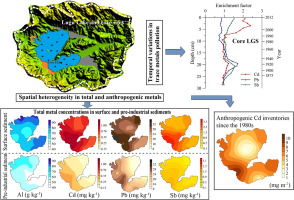当前位置:
X-MOL 学术
›
Sci. Total Environ.
›
论文详情
Our official English website, www.x-mol.net, welcomes your feedback! (Note: you will need to create a separate account there.)
Reconstruction of atmospheric trace metals pollution in Southwest China using sediments from a large and deep alpine lake: Historical trends, sources and sediment focusing
Science of the Total Environment ( IF 9.8 ) Pub Date : 2017-09-14 , DOI: 10.1016/j.scitotenv.2017.09.073 Qi Lin , Enfeng Liu , Enlou Zhang , Bibhash Nath , Ji Shen , Hezhong Yuan , Rong Wang
Science of the Total Environment ( IF 9.8 ) Pub Date : 2017-09-14 , DOI: 10.1016/j.scitotenv.2017.09.073 Qi Lin , Enfeng Liu , Enlou Zhang , Bibhash Nath , Ji Shen , Hezhong Yuan , Rong Wang

|
Atmospheric pollution, one of the leading environmental problems in South and East Asia, and its impact on the terrestrial environmental quality remain poorly understood particularly in alpine areas where both historical and present-day mining and smelting operations might leave an imprint. Here, we reconstructed atmospheric trace metals pollution during the past century using core sediments from a large and deep alpine lake in Southwest China. The implication of in lake and/or in watershed sediment focusing in pollution quantification is discussed by analyzing 15 sediment cores. Factor analysis and enrichment factor indicated Cd, Pb and Sb as the typical pollutants. Distinct peaks of Pb and Sb pollution were observed around the 1920s, but little Pb pollution was detected in recent decades, different from other studies in similar regions. Cadmium pollution was observed until the mid-1980s synchronized with Sb. The distinctive variations in atmospheric trace metal pollution process in Southwest China highlight the regional and sub-regional sources of metal pollutants, which should be primarily attributed to non-ferrous metal smelting emissions. Both natural and anthropogenic metals showed wide concentration ranges though exhibited similar temporal trends in the 15 cores. Spatial variations of anthropogenic metals were influenced by the in-watershed pollutants remobilization, whereas, natural metals were regulated by the detrital materials in the sub-basin. In-lake sediment focusing had little influence on the spatial distributions of all metals, different from the traditional sediment focusing pattern observed in small lakes. Anthropogenic Cd accumulation in sediments ranged from 1.5 to 10.1 mg m− 2 in a specific core with an average of 6.5 mg m− 2 for the entire lake, highlighting that a reliable whole-lake pollutant budget requires an analysis of multiple cores. Our study suggests that the management of aquatic ecosystem health should take the remobilization of in-watershed stored pollutants into consideration especially under increasing human perturbation.
更新日期:2017-09-15



























 京公网安备 11010802027423号
京公网安备 11010802027423号